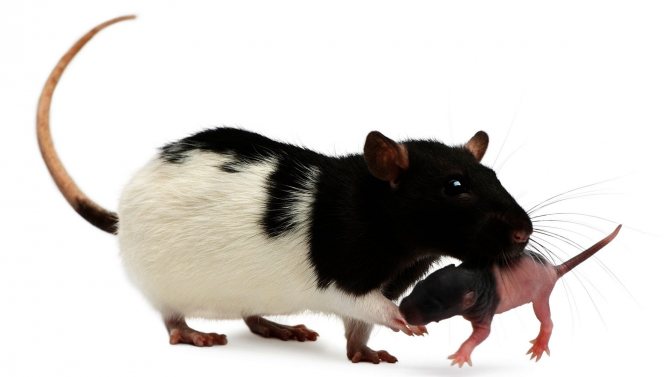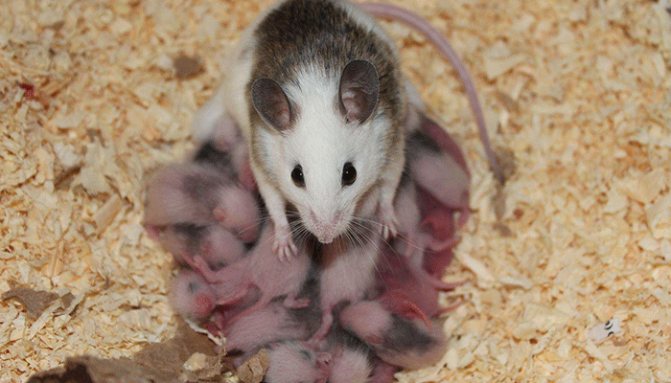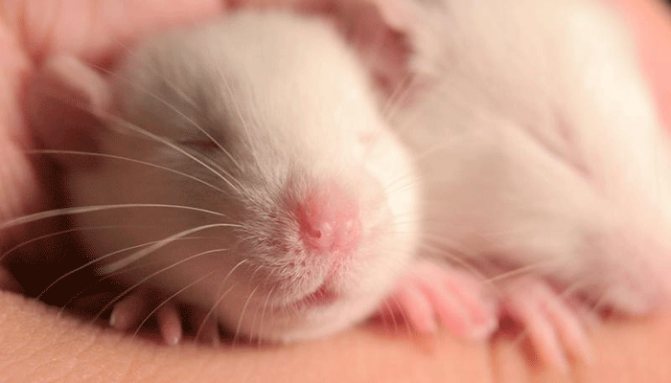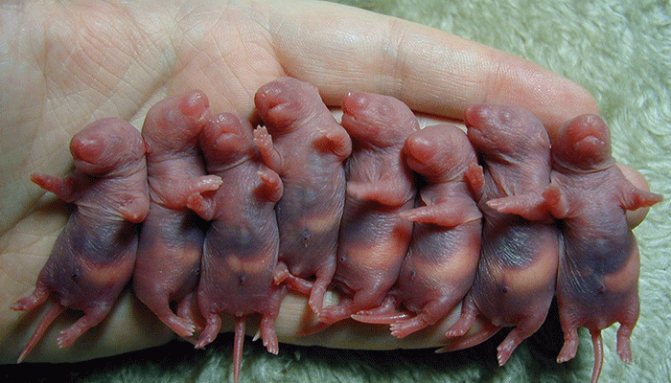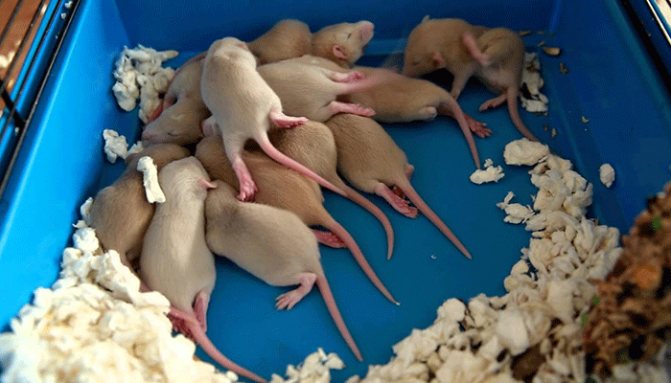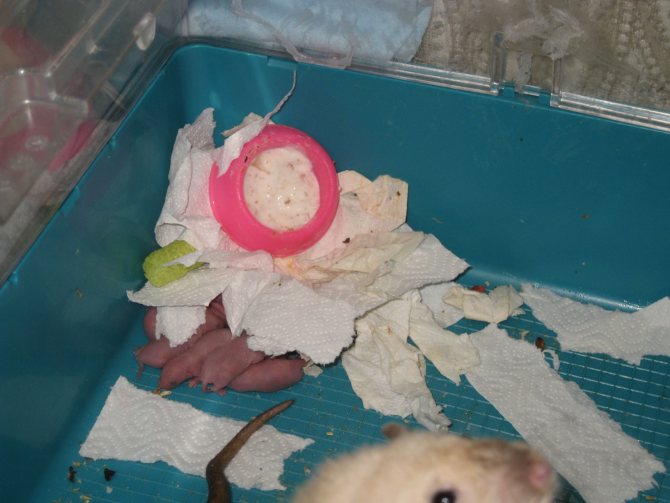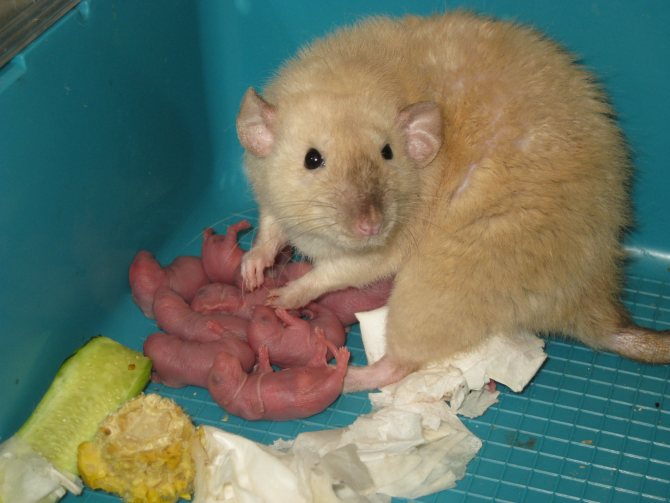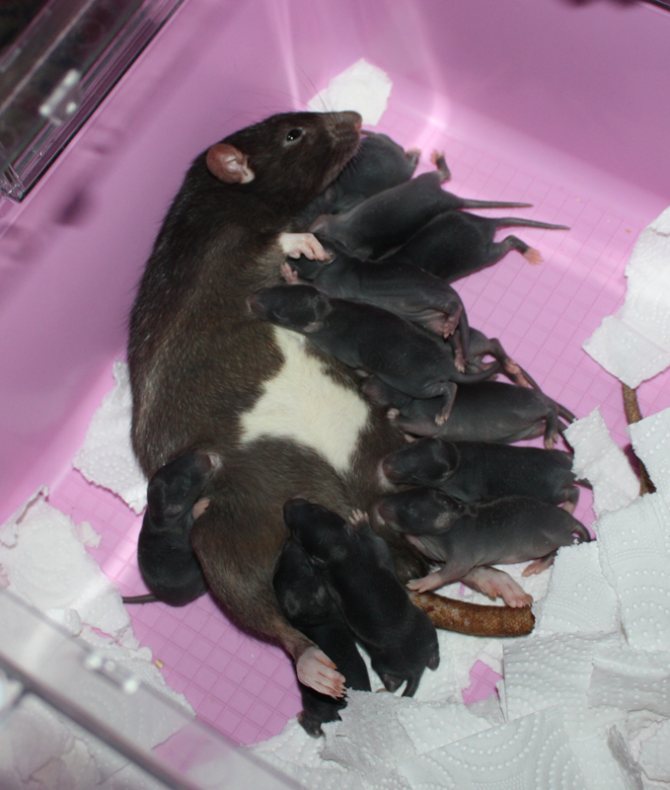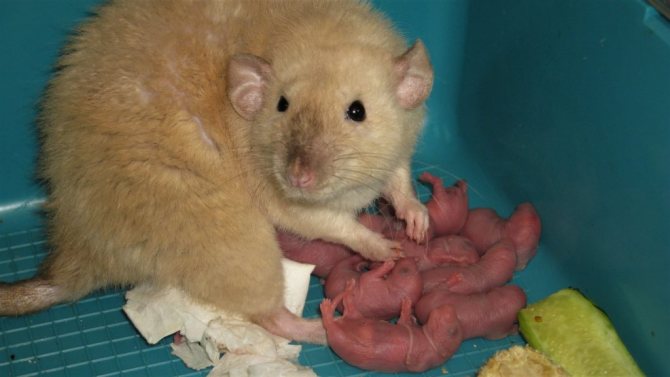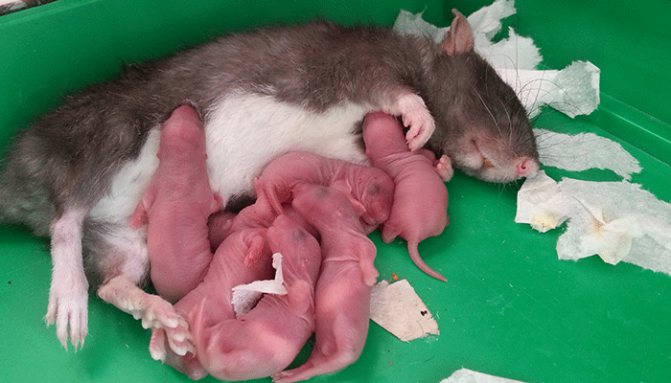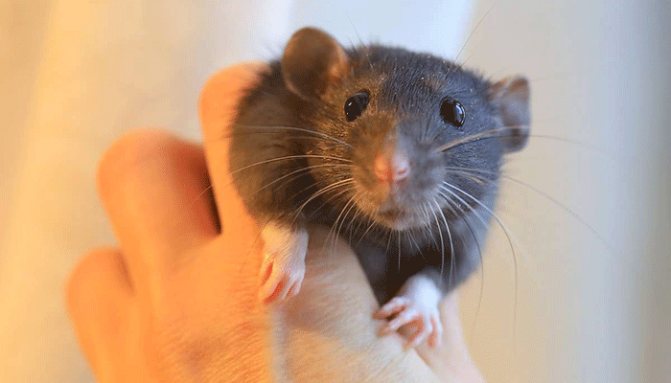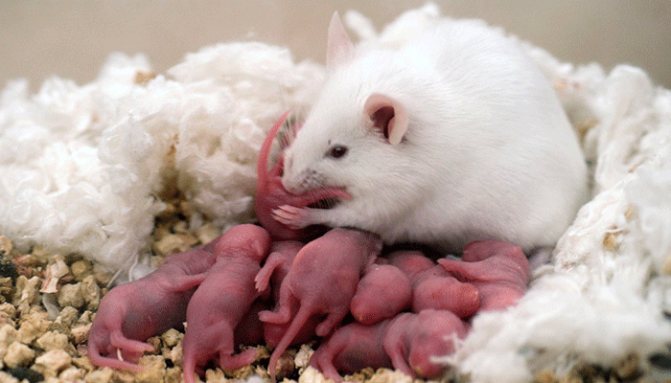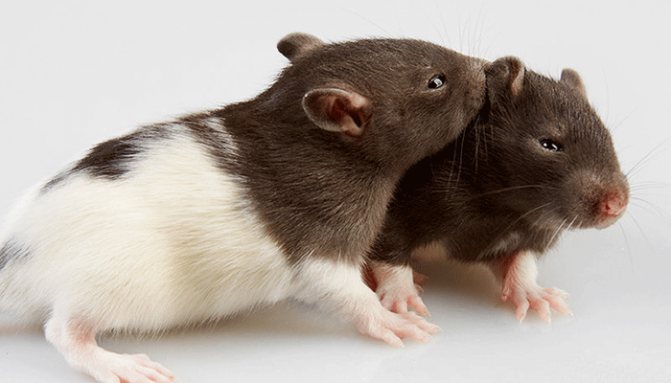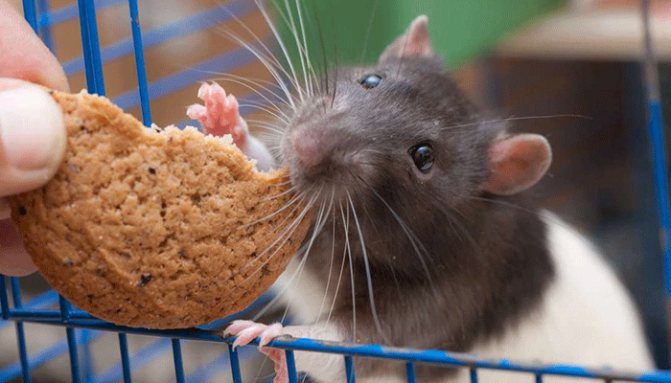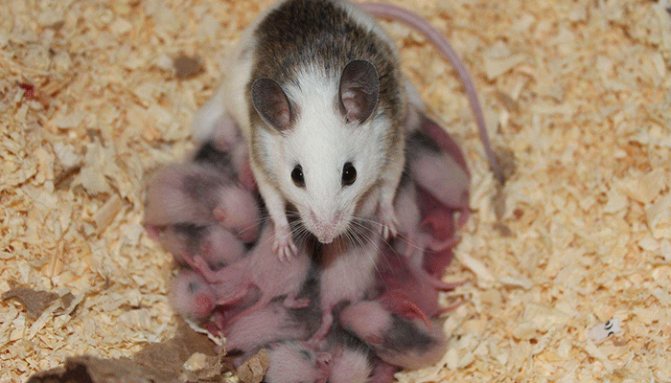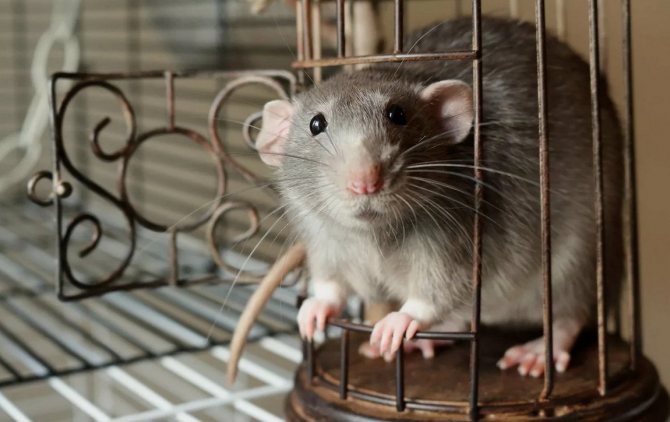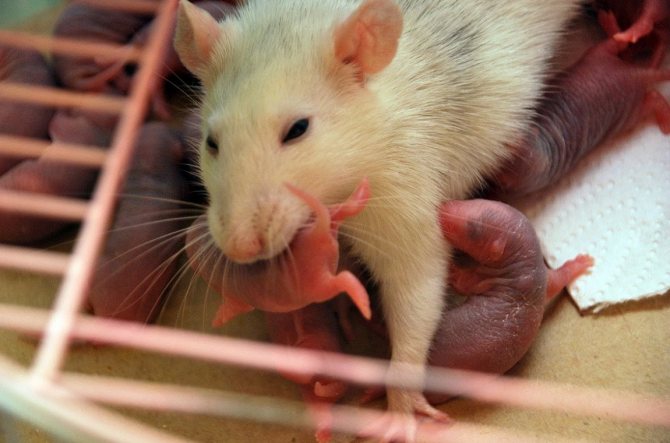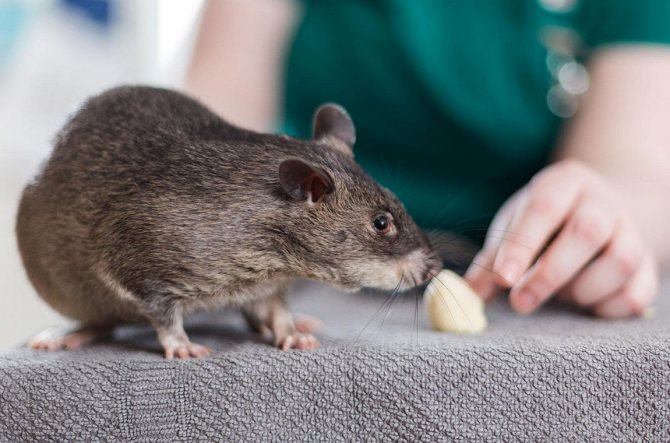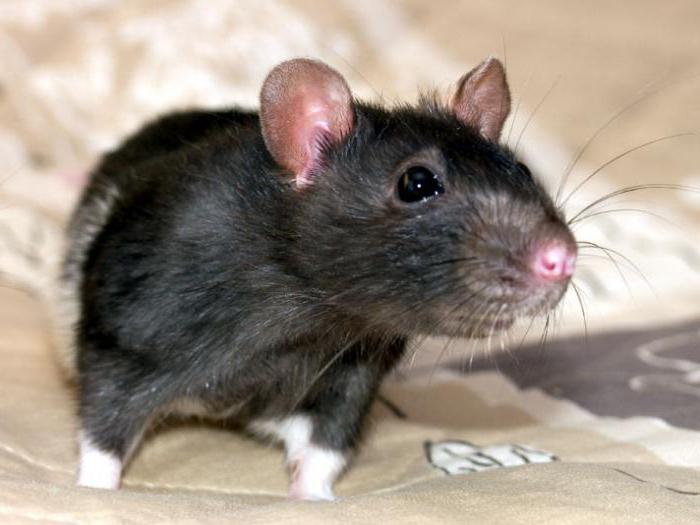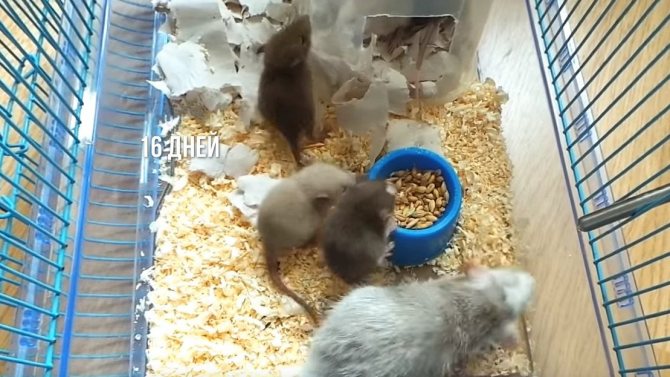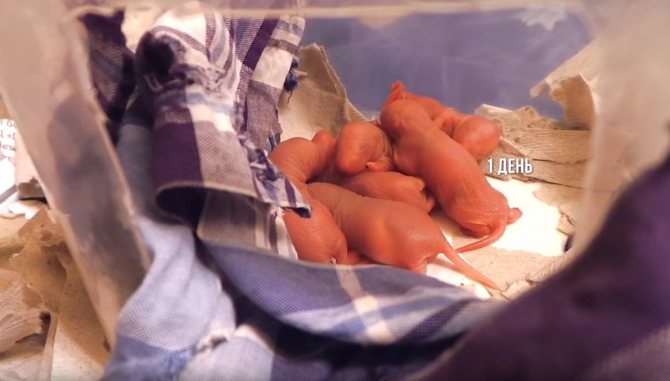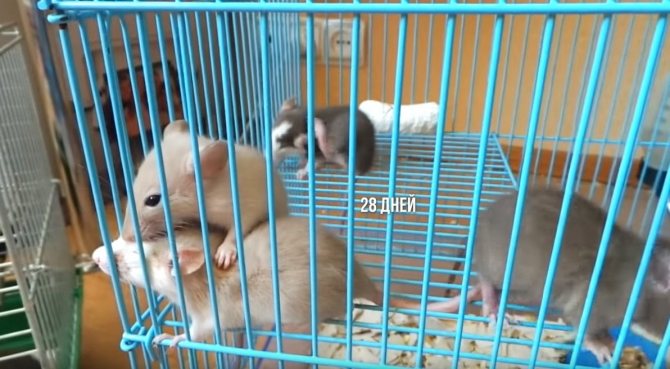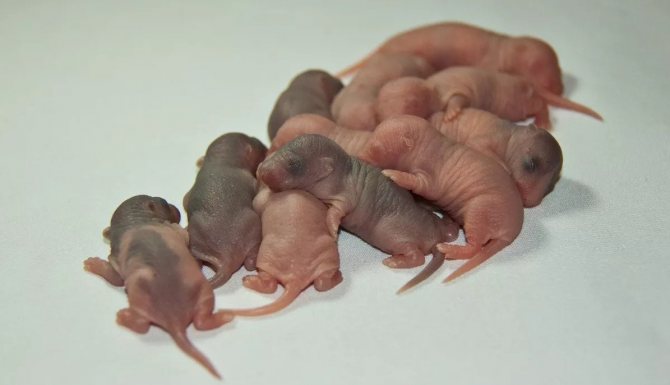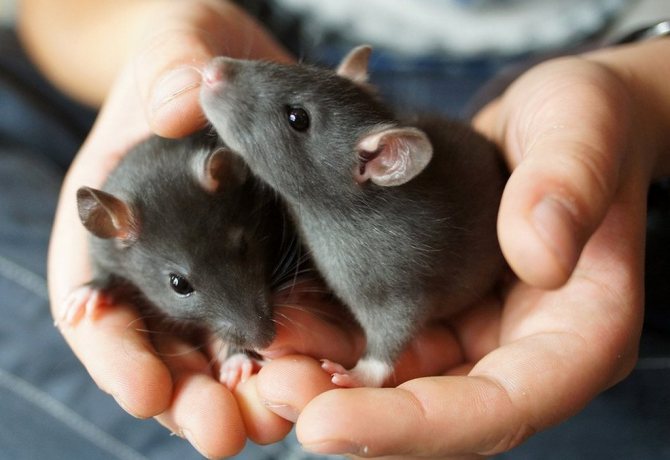Two weeks of pregnancy. A rat from the fund, which I have on overexposure.
Verdict - pregnant. The first thing to do is calm down and not panic. Before giving birth, the rat must live separately. Therefore, if it is possible to calculate the gestational age, place it in a separate cell in the last days of the term.
Pregnancy in rats lasts 22-24 days. Just living alone for all three weeks will be boring for the rat. But since there is a possibility that a girl may give birth among her fellow tribesmen, it is better to arrange for her to move immediately after discovering her “interesting position”.
Cell. The housing of the expectant mother, as well as her offspring, is a very important aspect. Choose a small cage, with a minimum distance between the rods, as pups are born very small and can fall into large holes. Low cells are preferred. Remove everything unnecessary from it. Remove shelves, houses, hammocks.
Leave only the drinker, a bowl well screwed to the rods, mineral stone, and white napkins / toilet paper (no dye or fragrance). Since many mothers build a nest into fanaticism, they can take everything that is not nailed as a material. Moreover, in the literal sense.
There were cases when rats carried bowls of food to the nest, and then the rats died from the severity, or suffocated in the viscous food. The filler also cannot be used with small rat pups.
The noses of "shrimps" (as the rat breeders call newborns because of their resemblance to real shrimps) are so small that any crumb can be the cause of their death.
Nutrition for the expectant mother, and even more so for the already nursing one, should be enhanced and varied. In addition to food, give the rat baby meat food and fruit purees, cereals, dairy products, fruits and vegetables, walnuts in a small amount, as well as tea with milk for better lactation.
Before giving birth, place the cage in a quiet, inaccessible place so that no one can disturb the family. Better if it is a darkened corner. If it is impossible to provide such a place, cover 2-3 walls of the cage with cardboard. In this case, there will be less noise, which means that no one will distract and irritate the rat.
Stay out of the cage during labor. Remember that they need calmness and warmth now. Do not allow drafts in the room, but the heat will not bring good either. Because rat pups are born completely bald, then their delicate skin can dry out and begin to peel off.
This is a signal that the air needs to be humidified.

The white stripe on the belly is milk. The pups, except for the first, are well fed.
On the second or third day, you can already let your mother go for walks. During her absence, check the pups. They should have visible milk in their belly, a large white stripe, which means the children are full. If she is pale or completely absent, then the kids are hungry. These rats need to be fed manually.
It is better to talk about this separately. In addition, you can take walks to clean the cage.The fact is that the mother can show aggression towards the owner when he reaches into her nest with his hand. Especially if there was no contact between them.
A tame rat will most likely be complacent about your intervention, but caution will not hurt.
After two weeks of age, the rat pups begin to open their eyes. Very soon after that, they turn into nimble and noisy cockroaches, which are difficult to collect in a heap. They already eat adult food and mineral stone, but mother's milk comes first.
If your family was in a small cage, then it's time to move them into a bigger house. After all, kids will need a lot of space to play. You can pick up rat pups from birth, but if you want the kids to grow up curious and tame, then pick them up as often as possible, communicate and play with them.
Start accustoming the rat pups to walking, but watch everyone carefully. After all, their movement speed is close to supersonic.
At the age of five weeks, all boys must be separated from their sisters and mother. At this age, they are already ready to reproduce and it does not matter for them who is next to them - mother, sisters or strangers' rats.
Remember - 5 weeks! In addition, now they can be given to new homes. Try to keep track of the fate of each baby so that they live well.
Handing over to the store is as easy as shelling pears, but you will never know for what purpose they will be purchased ...
Raising rat pups is one of the most enjoyable and joyful things to do. But even it is not worth the health of your rat, because during childbirth anything can happen: from dead rat pups to the death of a female. So don't breed rats for fun, just love them.
What affects the reproduction of rats
The age of the male is practically irrelevant, since even elderly individuals are able to fertilize the female. For breeding, healthy rats are selected that do not have respiratory tract diseases. The risk group includes animals that are sick or have had mycoplasmosis - such rodents should not be bred.


The heat in a female rodent can begin the next day after giving birth, but in order to obtain normal offspring, it is necessary to feed the previous one and rest for at least a week. Thus, the next conception should be in 4-5 months.
Important! Pets can mate with wild animals, but the survival rate of the fetuses of such contacts is zero.
Types of mice, names and photos.
The mouse family includes 4 subfamilies, 147 genera and 701 species, the most common of which are:
- The field mouse (lat.Apodemus agrarius) reaches 12.5 cm in size, not counting the tail, which can be up to 9 cm long. light gray. The striped field mouse habitat includes Germany, Hungary, Switzerland, Poland, Bulgaria, the southern part of Western Siberia and Primorye, Mongolia, Taiwan, the Korean Peninsula and some territories of China. This species of mice lives in wide meadows, in dense thickets of bushes, city gardens and parks, and makes a refuge both in burrows and in any natural shelters. In flooded areas, it builds nests on bushes. Depending on the season, the diet may consist of seeds, berries, green parts of plants and various insects. The field mouse is the main pest of grain crops.
- The yellow-throated mouse (Latin Apodemus flavicollis) has a reddish-gray color and a light abdomen (sometimes with a small speck of yellow). The body size of adults reaches 10-13 cm, the tail has approximately the same length. The weight of the mouse is about 50 grams. This type of mouse is widespread in the forests of Russia, Belarus, Moldova, Bulgaria, Ukraine, the Caucasus, northern provinces of China and Altai.Yellow-throated mice settle on open edges in tree hollows or dug holes, but they can also live in stony placers. Their diet includes both plant and animal foods. Eating young shoots of fruit trees, they cause significant harm to nurseries.
- The grass mouse (Nilotic grass mouse) (lat.Arvicanthis niloticus) is one of the largest representatives of the mouse family and can reach 19 cm in length, and together with the tail - 35 cm.The weight of individual large individuals exceeds 100 g. The fur of the back and sides has dark gray or grayish-brown color with separate stiff and spiny bristles of a darker shade. The color of the belly is light gray. This type of mouse is most common in African countries, where they live in bushes, forests and savannas. As a refuge, grass mice choose abandoned termite mounds or dig holes on their own, but on occasion they can penetrate human habitation. The diet of mice is based on plant foods.
- The baby mouse (Latin Micromys minutus) is one of the smallest rodents in the world. The body length of an adult animal does not exceed 7 cm, the tail is 6.5 cm, and the weight of the baby does not exceed 10 g. The back and sides are monochromatic and have a reddish brown or brown color, in contrast to the light gray, almost white belly. The muzzle of baby mice is short and blunt, with small ears. The distribution range of this species of mice stretched from west to east from the northwestern provinces of Spain to Korea and Japan, in the south to Kazakhstan, China and northern regions of Mongolia. The mouse lives in forest and forest-steppe zones, in meadows with tall grass. In the summer, mice use nests twisted in the grass as a refuge, and winter in burrows, haystacks, residential or outbuildings of a person. The diet of baby mice is based on seeds of cereals and legumes, as well as small insects. They often settle near granaries, causing enormous damage to agriculture.
- The house mouse (lat.Mus musculus) is the most widespread species on the planet from the rodent family. The body length of an adult mouse does not exceed 9.5 cm, and together with the tail - 15 cm. The weight of the mouse is 12-30 g. The color of the fur on the sides and back is gray with a brown tint, and on the abdomen from light gray to white. Individuals living in desert areas have a sandy color. The muzzle of the mouse is sharp with small rounded ears. The distribution area of this species of mice does not include only the territory of the Far North, Antarctica and high mountain regions. House mice live in all types of landscapes and natural zones, very often they penetrate into household and residential buildings of a person. Under natural conditions, minks dig independently, although they can also occupy dwellings abandoned by other rodents. They feed on seeds and juicy green parts of plants, and having penetrated into a person's house, they consume everything that falls into their teeth - from bread and sausages to paraffin candles.
- The striped mouse (Latin Lemniscomys striatus) is a small rodent: the body is 10-15 cm long, intermittent stripes of light colors are visible along the back and along the sides. Under natural conditions, striped mice rarely live more than 6-7 months, in captivity they live two to three times longer. The menu of these individuals includes mainly vegetable "dishes": root crops, unsteady seeds, juicy fruits, and occasionally small insects.
- The spiny mouse (akomis) (lat. Acomys) is a rather cute representative of the mouse family, the owner of huge eyes and the same big ears. The size of the needle mouse together with the tail is 13-26 cm, the back of the animal is covered with thin needles, like that of an ordinary hedgehog. An amazing feature of these animals is regeneration: in case of danger, the mouse is able to shed a piece of skin, leaving the attacker bewildered. The skin is quickly restored without damage to the individual. The spiny mouse lives in Asian countries, is found in Cyprus and Africa.In food, it focuses on plant foods, this animal is often kept as a pet.
We suggest that you familiarize yourself with the Symptoms and treatment of Schistosoma in humans
At what age do they begin to reproduce
The optimal age for the start of reproduction of these rodents is 4–5 months. During this time, they reach puberty, and are able to have healthy offspring. Females at the age of 6–8 months may have a narrowing pelvis, after which they are unable to give birth on their own. In this case, a caesarean section is applied, after which the female is discarded, since she will no longer be able to give birth on her own.
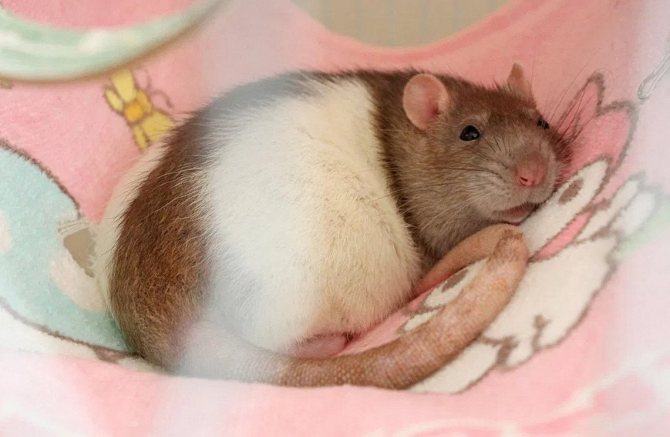

Re-fertilization is possible 3-4 weeks after the end of the feeding of the babies of the previous litter. And males are ready for intercourse always and at any age, and can begin to mate even in adolescence.
Rat heat
Heat in females occurs every 6–8 days and lasts about 12–14 hours. At this time, the animal behaves nervously, constantly moves, often chaotically. The rodent's labia are swollen from the rush of blood, which causes unpleasant sensations in the form of itching. In addition, mucous discharge appears.
Did you know? Rats in their normal state are able to jump to a height of 80 cm, and during stress they can "take off" two meters.
The behavior of young females (2-3 months old), which imitate sexual intercourse, is interesting. It is believed that these caresses have no special connection with erotic attraction to another individual of the same sex. Most likely, this is "friendly support", when another female imitates the swoop of the male, touching the back of the "partner", which brings pleasure and orgasm.
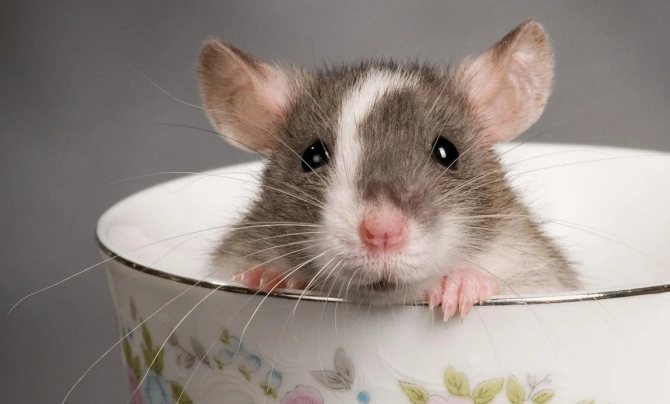

Ratmania
For some reason, people constantly strive to bring, breed, mate their animals, be it a cat, a rabbit or a rat. Regularly here and there, strikingly similar, like a blueprint, questions pop up: “I'm looking for a male / female to have babies”, “I'm looking for a groom for a rat, I want masiks”, “I have a male and a female, how should they be brought together to get rat pups "and phrases like:" I want the female to feel the joy of motherhood "," they also need to do THIS "," I want to continue the race of my rat, she is so good "," I want offspring "," the female will live longer. " And the questions of such unlucky owners, and their answers to the question "why?" say that they thought little and practically did not understand what they wanted to do. What awaits you if you decide to breed rats?


Childbirth does not add health!
They do not prolong life, do not reduce the risk of diseases of the reproductive organs (ovaries, uterus) and do not exclude the possibility of breast tumors. On the contrary, childbirth can aggravate existing health problems and the female can die thanks to your "experiments" with her life. Yes, this is an extreme case and does not happen to every female, but who guarantees that it is your beloved rat that does not have to lose its life due to a pathological pregnancy or unsuccessful childbirth (a rat stuck in the birth canal, bleeding)? Who guarantees that she does not become one of those females who had to be urgently taken to the veterinary clinic for a cesarean section and extraction of decomposing fetuses that poisoned her body, or because the rat was unable to give birth? Despite the fact that the cost of the procedure is not low (1-3 thousand rubles), outside big cities it is almost impossible to find a veterinarian who will agree and be able to operate on the rat, and no one will give guarantees that your rat will survive after the operation. Who guarantees that it is your beloved rat that will not undermine his health during childbirth and the exhausting five-week feeding of rat pups, of which there may be 15-20 in extreme cases, and will not start to get sick all the time (and this often happens this way)?
Your rat doesn't need a "family". And she doesn't need sex either.
Rats do not live in families, at all.They live in large groups, without a hint of monogamous * relationships, i.e. there can be no question of any "spouses". Moreover, in rat packs, not all rats are allowed to reproduce the offspring, i.e. It is by nature itself that rats can completely live without children, without suffering either morally or physically. For rats, children are not flowers of life, but a mechanism for the survival of a population, even in spite of their own health. And no, your rat does not suffer, because he has no sex - sexual intercourse in rats lasts exactly 2 seconds. What kind of pleasure can we talk about? In addition, the male, who has never seen a female at puberty, does not even think about sex, he simply does not know what it is. And no, your female does not want a "boy" - estrus is an automatic physiological process, she does not say anything about the desire for copulation with the opposite sex, the rat does not suffer from this, and certainly the rat, vibrating its ears, does not shout "I want to give birth to 15 spinognuts" ... For "sex" rats will thank you in full: changes in character, behavior, psyche. Almost all males, after mating, begin to "swing rights", becoming more aggressive both in relation to comrades and in relation to people, including the owner. Females sometimes become aggressive already in the last stages of pregnancy and are almost guaranteed after giving birth and while feeding rat pups, so they instinctively protect their offspring from encroachments, violently attacking everything that is near the nest, including your hands.
* Monogamy is a relationship between the sexes, in which a male mates with the same female for a long time and takes part in raising and protecting the offspring.
There will be many rats
Lots of! Perhaps there will be 20 of them, although the average number of pups in a litter ranges from 12-15. Where are you going to take them? All your friends, relatives, acquaintances, neighbors, who so wanted the little rat, will suddenly tell you that they didn’t hurt and wanted to, they had an allergy, their parents forbade them, they move, the cells turned out to be too expensive and, in general, a pet for them now to nothing. And you also did not take into account that a crowd of black and agouti rats, or even albinos, can be born from rats with interesting colors, but they are completely, completely unnecessary, because they are too commonplace. Believe me, it will be so, and you will stay with your 15 rats who ask for food, who make noise and pollute the cage, for half of which (males) will need a second cage, in which they will need to be transplanted at the age of five weeks, otherwise the number of rats in you will begin to grow exponentially. The older the rat pups become, the more money will be spent on them and the more inconvenience they will cause. You will try to attach them through the message boards or turn in to the pet store, because there they will be taken care of. There, kind people will be able to buy your rat pups for dinner for their reptile or ferret, as a toy for a cat or child, for a gift that the gifted ones are somehow not particularly happy with and later get rid of in any available way. This is if the pet store generally agrees to take them from you, they often work with permanent "suppliers", and they flatly refuse to accept live goods from spontaneous "breeders" (and some, if they agree, require a certificate from a veterinarian, which will cost you a lot) ... It is even more convenient, if you are lucky, to hand them over in bulk to a kind person who will tell you that he will be engaged in their further attachment, but in fact, on the same day, will put them in the freezer and then “defrost” feed his domestic bird of prey. And if there are no such "helpers", then all your 15 rats will remain with you, gradually turning into adults, useless rats ... You want such a fate for those whom you created by your whim and for whose life you thereby took upon yourself a responsibility?
It has long been known that reptiles do not hesitate to purchase food for their predatory animals by deception. They are not interested in the fact that you raised rats for love and a long life. For them your future rat pups are no more than KOs - food objects.
Health and heredity
Only and exclusively healthy animals, without previous (serious) diseases, should be allowed to breed. It is an axiom that a sick rat cannot produce healthy offspring. But even if your rat is healthy, the question arises about its heredity, because you do not know what its grandparents, brothers-sisters were ill with, and this can be reflected in its rat pups with full force - starting with the fact that genetic abnormalities and hereditary diseases can lead to the birth of dead or non-viable offspring, rat pups with mutations (manx), serious diseases (hydrocephalus, megacolon), tendencies to oncological diseases (leukemia) and the appearance of various neoplasms (brain tumors, mammary gland tumors, melanoma, neoplasms in internal organs ), a tendency to diseases of internal organs (heart, liver, lungs) and ending with poor immunity in offspring and the appearance of chronic respiratory diseases at a young age. Is your desire to breed your rat worth the consequences for its offspring? Do you want rat pups to have such a future? Have you thought about their future owners, who will suffer and heal their rat all their lives? Isn't it easier to give a home to another rat that needs an owner, and not to continue this conveyor of not very healthy animals with your own hands?
Continuation of the family of the beloved rat ...
Your rat is wonderful and the best, there is no doubt about it. But, unfortunately, her children will not look like her in anything except color (and not always in color). These will be completely different rats. The idea of recreating your pet in his children has arisen in front of many rat breeders, but most of them are still stopped by common sense - this same beloved rat may die during pregnancy / childbirth, and her children may end up with unworthy people or become whose something with food.
Knowledge is light!
Before starting to breed rats, you need to gain a lot of knowledge regarding the maintenance, treatment and genetics of rats, drawing information from forums and direct communication with experienced rat breeders and breeders, and as for treatment and maintenance, personal experience is most important here, supported by the advice of competent people. ... That is, you need to "outlive" a lot of rats before you yourself become this experienced rat breeder. This knowledge is not obtained in days, weeks or months; it takes a couple of years. Only in this case, you will be able to avoid the problems described above with a high degree of probability, but even then the possibility of a tragic outcome cannot be ruled out, so you need to think carefully before the last step, because there will be no turning back. Of course, if you want to become an ordinary breeder who does not care about the comfort and health of your rats and the future of rats, and you put your "wants" above everything else, then go ahead, right now ... but do not be surprised later, reaping the fruits of your actions.
By Katharina From Photo courtesy of Marina Shark Thanks to the users of Ratmania for the advice and help in writing this text.
How to choose a female and a male for breeding
For breeding, a sexually mature healthy pair is formed. You can add 2-3 females to one male, then the fertilization process will be more effective, - high-quality quickly and with several females at once.
The ideal age for the process of first intercourse and childbirth of a female is 4–5 months; males can be taken in any age category. Adults are examined visually for diseases, and are deposited in a separate cage for future reproduction.
Find out also about the lifespan of ornamental rats.
Rat character
This phrase sounds intimidating and even a little unpleasant. But in reality, the pet rat (reviews of the owners indicate this) has an excellent character and a number of advantages that make this rodent a favorite pet in many families.
The rat, as a pet, is not inferior to the cat in cleanliness. She also washes her face often. With proper and timely cleaning of the cage, there will be no unpleasant odor in the house. Keeping a domestic rat can be combined with training this animal. Do not be surprised, but these animals, like dogs, can carry out various commands - "stand", "lie down", "sit" and others. The treat will help you achieve results.
We suggest that you familiarize yourself with: American Hairless Terrier: breed description
We can say that rats are omnivorous. But in this article we will tell you what you should not feed these rodents. It is very interesting to observe these animals in a well-equipped cage: with a wheel, all kinds of rings and pipes. Rats dexterously use their tail and their prehensile legs.
Mating process
Usually a pair or a male and 2-3 females are sown separately for 8-10 days. During this time, each rat is guaranteed to pass up to two leaks when they are ready to reproduce. The aggressiveness of the rat during this process can lead to a lack of intercourse.


The male can mate with another friend, or after a few days the chosen female will let him back to her. This process is fleeting and after a couple of minutes, sexual intercourse may be repeated.
Important! If for some reason the animals have only a short period of time for mating (for example, they belong to different owners), then it is better to bring the female to this procedure during estrus.
Food
The diet of mice depends on the habitat. Rodents are omnivores, able to eat anything that seems edible.
In wild nature
The diet is based on various plants and crops. Mice tend to store for the winter: dry seeds, bark of young trees, mushrooms, grains, nuts, acorns, plant roots. The total mass of stocks can be up to 3 kg.
In some cases, rodents are able to act as small predators, eating various insects: grasshoppers, spiders, worms. There are cases when mice have entered bee hives. Rodents ate dead bees, and when they ran out, they attacked the living. Another discovery was that rodents began to eat bee bread and honey, which bees need in winter.
The period of activity of the animals falls on the night time, approximately from 22:00 to 6:00. At this time, they search for food, mate, explore the surrounding territories. In the afternoon they sleep in a shelter.
It turns out that cheese not only does not attract rodents, but also scares them away. This fact has been proven by scientists.
In winter, the animals do not hibernate, but remain active, feeding on the stocks collected in the fall. During this period, they practically do not leave the shelter. If food runs out, the rodent leaves the nest and begins to panic search for food sources, becoming vulnerable to predators.
At home
Animals living next to humans have a great appetite and consume a considerable amount of food.
The main food of domestic mice are grains: wheat, oats, barley, rye. They contain enough protein, carbohydrates and vitamins with a small amount of calcium. Often, brown bread and crackers are included in their diet to grind down the ever-growing incisors. Dairy products cannot be tolerated, so they must be completely excluded from the diet.
What mice eat as supplemental food:
- potatoes;
- apples;
- melons;
- grapes;
- young shoots of nettles;
- dried fruits;
- cucumbers;
- raspberry branches;
- zucchini;
- green parts of plants.
Seeds and nuts play a significant role in their diet, but their excessive use can cause rapid obesity, which affects the health of the animal.
We suggest that you familiarize yourself with How to wash a tie at home
Domestic mice eat cockroaches, and cases of cannibalism are also frequent: large individuals devoured smaller representatives of the species. This does not happen in the wild, as wild mice are smaller and more agile and move more. Domesticated ones are larger, live in a small area, make much less movements. This becomes the main reason for their "clumsiness", aggressiveness.
How to care for a pregnant rat
During pregnancy, a rat needs only two conditions for high-quality bearing of offspring - good nutrition and physical activity. It is necessary to give the animal the opportunity to build a nest for its future babies. To do this, dry, decontaminated straw, sawdust, paper, scraps of cloth and even tow are placed in a cage or aviary. The rat itself will choose the "right" materials and how many of them are needed to equip the nest.
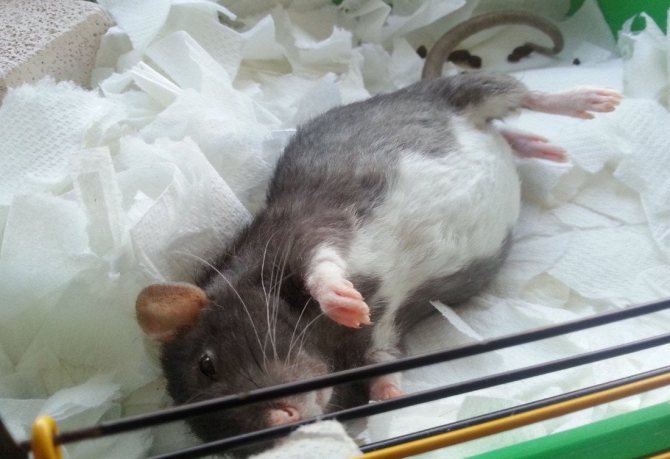

Preparing for childbirth
It so happens that amateur rat breeders are not up to the last aware of the female's pregnancy. Little is visible in its behavior - the rat also cheerfully jumps over the perches, sways in a hammock and generally behaves at ease. She only gains weight after three weeks. And, if the owner feeds his pet well, then in principle it may look as if she has slightly recovered. You should be on your guard when the rat begins to "roll" and actively nest. Everything that comes to hand goes to the arrangement of the nest. Papers, various scraps and scraps of something incomprehensible, filler, in general, everything that is in the access zone of our lady. And it will bite off the curtain if it reaches. Here it is highly desirable not to miss the moment and move the male out. Two or three days before giving birth, the rat becomes nervous and irritable, begins to terrorize the "husband", suspecting him of the worst intentions. The male, in turn, is really capable of gnawing newborn cubs.
What should be done
So, at that time, how long a rat's pregnancy lasts, she needs to find building materials for arranging the "frontal place". Toilet paper or unflavored paper towels will work. Tear a few leaves very finely so that the children born are not lost among the pieces of paper. Secure all moving objects: bowls, drinker, hammock. A house without a bottom should be removed, and a house with a bottom should not be cramped - places need to be organized for everyone who wants to come to this world.
In general, you can limit yourself to some pieces of paper. There should be no sawdust, filler, rags with long threads either - the paws and tails of little rat pups can get tangled in them. Everything in babies is very delicate and fragile, limbs can come off, babies' noses are very small, and any crumb can be fatal for them. The cage should be in a warm, dry, calm place, not on the floor or in direct sunlight. Better if it is a darkened corner. There should be a minimum distance between the bars of the cage. Rats are born tiny and can accidentally fall out through large holes.
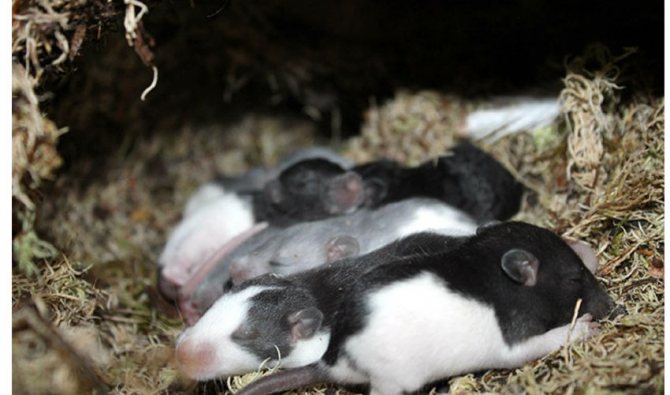

How rats give birth
Childbirth usually takes place at night and lasts from one to four hours. The rat lies down, and during this time it does not need to be disturbed until the process is completed. With the beginning of the birth process, the male needs to be planted, since the female will start estrus the next day, and she needs to feed her cubs and a new early pregnancy can lead to the loss of offspring.
Did you know? A small rat at the moment of fright is able to make a sound equal in power to a perforator. Only the frequency of this sound will not be perceived by the human ear.
What does a mouse eat?


The basis of the diet of mice is plant food: grass seeds, fruits of trees or shrubs, and cereals (wheat, oats, barley, millet, buckwheat).Mice that live in wetlands, wet and flooded meadows feed on leaves, buds or flowers of plants and shrubs. Some types of mice prefer a protein supplement as insects, worms, beetles, spiders. Once at home, these animals happily gnaw potatoes, sausages, baked goods, eggs or cheese.
The mouse does not fall into hibernation and can move under the snow crust without appearing on the surface. To survive the cold, she has to create substantial food supplies in the pantries arranged near the entrance to the burrow.
How many rat pups are born in a litter
The usual number of litters for the first time is up to 12 pups - according to the number of their mother's nipples. However, anomalies also occur when a female can give birth to 1 to 22 babies. At the same time, cubs can be born all viable or partially dead offspring. There is a high probability of death of rat pups due to lack of nutrition (lack of free nipples).
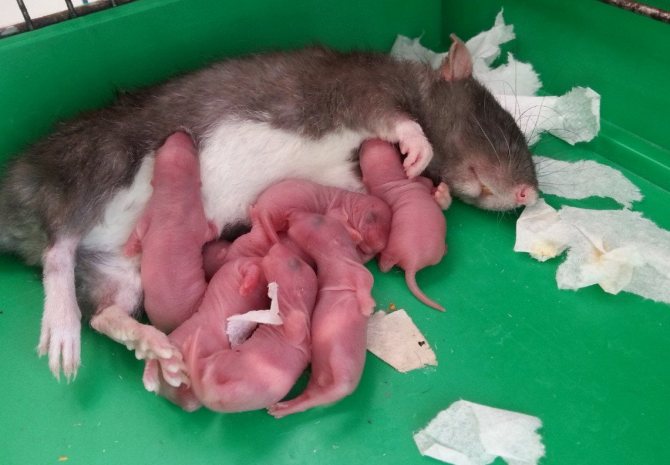

When the number of newborns is more than 12, the female is able to feed them, but in this case it is necessary to provide her with high-calorie food and create conditions for rest between feedings. You also need to pay attention to the nest - increase it, insulate it. In good conditions, the rat will feed the babies in two "shifts", then there is no need to reject them.
Artificial feeding
In some cases, when the female dies after giving birth or refuses to feed, the cubs can be tried to feed the child's family. For this, insulin syringes are used. Infant formula is taken in a proportion of 1 part to 50 ml of condensed milk with a high fat content of up to 12%, including half a calcium gluconate tablet. The use of milk replacers for cats or dogs is acceptable.
Feeding should be done often with a gradual increase in portions. It is preferable to give such cubs to another lactating female if she accepts them.
In conclusion, it should be said that breeding rats is quite an exciting process, but do not forget that by crossing different species, you can create something completely unusual.
- Similar posts
- Types and breeds of decorative rats
- Is it possible and how to trim the claws of a rat
- The rat itches to blood, why?
«Previous post



